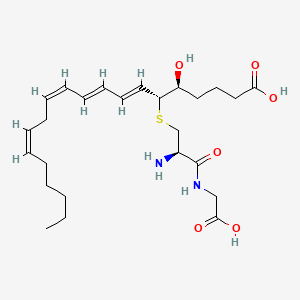| Leier I et al. |
The MRP gene encodes an ATP-dependent export pump for leukotriene C4 and structurally related conjugates. |
1994 |
J. Biol. Chem. |
pmid:7961706
|
| Bannenberg G et al. |
Leukotriene C4 is a tight-binding inhibitor of microsomal glutathione transferase-1. Effects of leukotriene pathway modifiers. |
1999 |
J. Biol. Chem. |
pmid:9890956
|
| Garcia C et al. |
Effects of synthetic peptido-leukotrienes on bone resorption in vitro. |
1996 |
J. Bone Miner. Res. |
pmid:8992883
|
| Fang SH et al. |
Pranlukast attenuates ischemia-like injury in endothelial cells via inhibiting reactive oxygen species production and nuclear factor-kappaB activation. |
2009 |
J. Cardiovasc. Pharmacol. |
pmid:19129732
|
| Kim MH et al. |
Effect of leukotriene D4 on mouse embryonic stem cell migration and proliferation: involvement of PI3K/Akt as well as GSK-3β/β-catenin signaling pathways. |
2010 |
J. Cell. Biochem. |
pmid:20589831
|
| Cosentino S et al. |
Expression of dual nucleotides/cysteinyl-leukotrienes receptor GPR17 in early trafficking of cardiac stromal cells after myocardial infarction. |
2014 |
J. Cell. Mol. Med. |
pmid:24909956
|
| Geirsson A et al. |
Potentiating effects of pertussis toxin on leukotriene C4 induced formation of inositol phosphate and prostacyclin in human umbilical vein endothelial cells. |
1998 |
J. Cell. Physiol. |
pmid:9731750
|
| Al-Azzam N et al. |
Modulation of mast cell proliferative and inflammatory responses by leukotriene d4 and stem cell factor signaling interactions. |
2015 |
J. Cell. Physiol. |
pmid:25161061
|
| Li PC et al. |
Enhanced activity of Ca2+-activated K+ channels by 1-[2-hydroxy-3-propyl-4-[(1H-tetrazol-5-yl)butoxyl]phenyl] ethanone (LY-171883) in neuroendocrine and neuroblastoma cell lines. |
2002 |
J. Cell. Physiol. |
pmid:12115725
|
| Capra V et al. |
CysLT1 receptor is a target for extracellular nucleotide-induced heterologous desensitization: a possible feedback mechanism in inflammation. |
2005 |
J. Cell. Sci. |
pmid:16306225
|
| Massoumi R and Sjölander A |
Leukotriene D(4) affects localisation of vinculin in intestinal epithelial cells via distinct tyrosine kinase and protein kinase C controlled events. |
2001 |
J. Cell. Sci. |
pmid:11329379
|
| Massoumi R et al. |
Leukotriene D(4) induces stress-fibre formation in intestinal epithelial cells via activation of RhoA and PKCdelta. |
2002 |
J. Cell. Sci. |
pmid:12154081
|
| Paruchuri S et al. |
Leukotriene D(4) activates MAPK through a Ras-independent but PKCepsilon-dependent pathway in intestinal epithelial cells. |
2002 |
J. Cell. Sci. |
pmid:11956320
|
| Meng XJ et al. |
Leukotriene D4 activates a chloride conductance in hepatocytes from lipopolysaccharide-treated rats. |
1997 |
J. Clin. Invest. |
pmid:9185515
|
| Soberman RJ and Christmas P |
The organization and consequences of eicosanoid signaling. |
2003 |
J. Clin. Invest. |
pmid:12697726
|
| Datta HK et al. |
Parathyroid hormone induces superoxide anion burst in the osteoclast: evidence for the direct instantaneous activation of the osteoclast by the hormone. |
1996 |
J. Endocrinol. |
pmid:8708538
|
| Bandeira-Melo C et al. |
Intracrine cysteinyl leukotriene receptor-mediated signaling of eosinophil vesicular transport-mediated interleukin-4 secretion. |
2002 |
J. Exp. Med. |
pmid:12235216
|
| Uemura M et al. |
Cysteinyl leukotrienes in the bile of patients with obstructive jaundice. |
2002 |
J. Gastroenterol. |
pmid:12424566
|
| Gyömber E et al. |
Effect of lipoxygenase inhibitors and leukotriene antagonists on acute and chronic gastric haemorrhagic mucosal lesions in ulcer models in the rat. |
1996 |
J. Gastroenterol. Hepatol. |
pmid:8912128
|
| Lefebvre B et al. |
Effect of 5-lipoxygenase blockade on blood pressure and acetylcholine-evoked endothelium-dependent contraction in aorta from spontaneously hypertensive rats. |
2006 |
J. Hypertens. |
pmid:16331105
|
